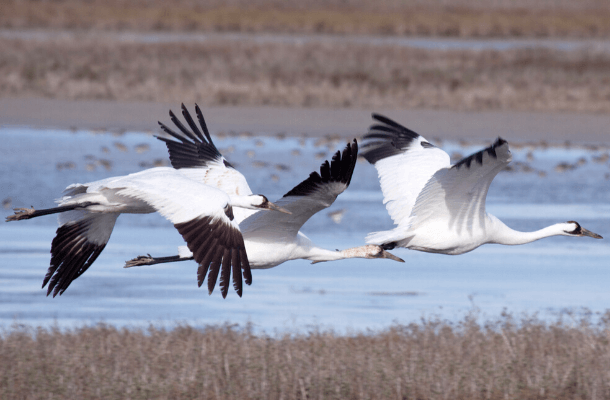Wind Turbines Deter Whooping Cranes From Stopover Sites, Study Confirms

New research confirms that Whooping Cranes avoid wind turbines, causing loss of important stopover habitat for this species during migration. Photo by Laura Erickson
A new study published this month (March 2021) in the journal Ecological Applications reveals that migratory habitat for the Whooping Crane is being gradually reduced by wind energy development. Researchers found that this Endangered bird avoids turbines to a distance of 3.1 miles (5 kilometers), eliminating otherwise usable stopover sites if turbines are placed too close to them. Five percent of the best stopover habitat has already been functionally lost, the authors found. Many more wind facilities are being planned, indicating that unless steps are taken to distance turbines from stopover sites, this situation could grow even more dire.
“The results of this ground-breaking study are really eye-opening — the buildout of wind energy is already having a negative cumulative impact,” says Joel Merriman, Director of the Bird-Smart Wind Energy Campaign at American Bird Conservancy. “There are more than 10,000 wind turbines scattered throughout the Whooping Crane's migratory pathway. We now know that too many of these turbines are eliminating important migratory stopover habitat for this Endangered species.”
Each year, the last naturally occurring Whooping Crane population makes a 5,000-mile round trip, moving north in spring then south in fall along a narrow corridor between Canadian breeding grounds and wintering grounds in coastal Texas. Not marathon flyers, the birds must stop to rest and refuel several times along each seasonal journey.
There are a handful of well-recognized major stopover sites where migrating Whooping Cranes reliably concentrate that are designated Critical Habitat by the U.S. Fish and Wildlife Service. However, there are other stopover sites that these birds need as “stepping stones” to successfully complete their journey. Maintaining the availability and quality of these sites is a critical element of the continued conservation of this species. Many are on private lands, making protection more challenging. The study indicates that these smaller stopover sites are being functionally lost due to wind energy development.
And these impacts are growing. In the timespan of the study, from 2010 to 2016, the number of turbines quadrupled in the center of the migratory corridor. Overall, wind turbine placement was found to be essentially random in relation to Whooping Crane stopover habitat.
The study shows that Whooping Cranes avoided areas within 5 kilometers of wind turbines. Essentially, the presence of turbines rendered any habitat within that distance unusable.
This problem will only continue to grow unless turbine siting practices are improved. “There is good news here as well,” says Merriman. “The study also provides a clear blueprint for preventing additional migratory habitat loss from wind energy development: Avoid placing turbines in the species' migratory pathway and absolutely stop putting them within 5 kilometers of stopover sites.”
The Whooping Crane has been clawing its way from the brink of extinction for almost a century. One of the rarest and most threatened North American bird species, the crane's population had dropped to a low of fewer than 20 individuals in 1941. After many decades of collaborative conservation work by U.S. and Canadian partners, today the population stands at more than 800 individuals. About 500 of these constitute the only self-sustaining population, which nests in Canada's Wood Buffalo National Park and winters in and near the Aransas National Wildlife Refuge in Texas. There are two substantial reintroduced populations — a nonmigratory flock in Louisiana and a second migratory population in the eastern U.S. — plus about 150 birds in captivity.
Wind turbines are, unfortunately, just one part of the issue for Whooping Cranes. For some wind energy facilities, and particularly those in more rural locations, new powerlines must be constructed to connect the new facility to the energy grid. Powerlines are a primary source of mortality for Whooping Cranes due to collisions while in flight. This is one of the reasons a permit was canceled in June of this year for the “R-Project,” a proposed 200-mile transmission line that would have crossed an ecologically sensitive part of southeastern Nebraska.
“We need wind energy to combat climate change, but we have to be smart about facility development,” says Merriman. “This is particularly important for rare species like the Whooping Crane that have slow reproductive rates and thus less ability to recover from losses. These birds have enough challenges, including a small population, continued habitat loss, powerline collisions, illegal shooting … the list goes on. Now they're also having to dodge wind energy facilities. We can't afford to stand by while this species' remaining habitat is lost, especially when this loss is so clearly preventable.”
ABC thanks the Leon Levy Foundation for its support of ABC's Bird-Smart Wind Energy Campaign.
###
Media Contact: Jordan Rutter, Director of Public Relations, 202-888-7472 | jerutter@abcbirds.org | @JERutter
Expert Contact: Joel Merriman, Bird-Smart Wind Energy Campaign Director | jmerriman@abcbirds.org
American Bird Conservancy is a nonprofit organization dedicated to conserving birds and their habitats throughout the Americas. With an emphasis on achieving results and working in partnership, we take on the greatest problems facing birds today, innovating and building on rapid advancements in science to halt extinctions, protect habitats, eliminate threats, and build capacity for bird conservation. Find us on abcbirds.org, Facebook, Instagram, and Twitter (@ABCbirds).


















































